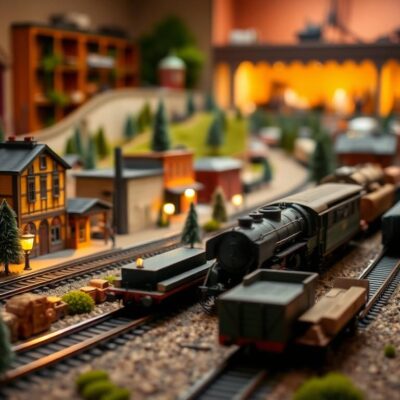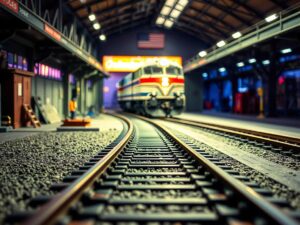
Understanding HO Scale Turnouts for Beginners
Understanding HO Scale Turnouts for Beginners
Welcome aboard, aspiring conductors! Today, we’re diving into the fascinating world of HO scale turnouts, those crucial pieces that allow trains to smoothly switch tracks on your model railroad layout. As a fellow hobbyist who loves nothing more than watching trains weave their way across intricate trackwork, I’m thrilled to guide you through this essential element of building a realistic and engaging railroading experience.
What Exactly are Turnouts?
Before we delve into the specifics, let’s clarify what “turnouts” mean. Simply put, they’re miniature railway switches that direct train traffic along designated paths. Imagine them as traffic signals guiding trains on your miniature metropolis!
In HO scale, one of the most popular sizes due to its detailed models and versatile layout possibilities â these turnouts are essential for creating realistic switching operations and simulating diverse railroad scenarios.
The Different Types of Turnouts:
The world of HO scale turnouts offers a variety of designs, each with unique characteristics suited to different applications:
- Manual vs. Electronic:
- Manual turnouts require a physical hand-cranked operation to switch the rails. They offer a satisfying tactile experience and can be incorporated into stunningly realistic setups where passengers watch the conductor meticulously handle each switch.
- Electronic turnouts, on the other hand, utilize electronic signals or controllers to seamlessly activate and deactivate switches remotely. This brings immense convenience for complex layouts with numerous switches and offers seamless integration with DCC (Digital Command Control) systems.
- Switch Throw Types: The type of “throw” describes how the switch points are angled to direct trains.
- Standard turnouts utilize a right-angle throw, making them easy to integrate into straight track runs and common mainline routes.
- Crossover turnouts employ curved throws that intersect tracks at different angles. This design is perfect for building elaborate branch lines or creating realistic junction scenarios where trains seamlessly transfer between tracks without abrupt changes in direction.
Choosing the Right Turnout for Your Layout:
Selecting the correct turnout type depends on your specific needs and desired operating scenario. Here’s a quick guide to help you decide:
- Beginners: Opt for basic manual right-angle turnouts for simplicity and affordability.
- Expanding Layouts: Electronic turnouts with DCC integration offer flexibility and remote control, essential for complex operations and dynamic scenarios.
- Specific Requirements: Crossover turnouts are ideal if you envision intricate junction designs or specific railroad operational needs.
A Deep Dive into Track Switches and Turnout Construction:
Now let’s break down the inner workings of these fascinating miniature switches! A HO scale turnout consists of several key components:
- Stock Rail: This stationary section forms part of both the incoming track (straight or curved) and the main outgoing route. Think of it as the primary path where trains normally travel.
- Switch Point Rails: These are the movable rails that guide the train either onto a branch line (a diverging route) or the straight through track. When moved, they form a “V” shape directing traffic appropriately.
- Tongue: This triangular piece is integral to the switch point’s mechanism and rotates to activate or deactivate the switch throw.
- Mechanism Housing: This contains the levers or gears responsible for switching the tongue and points. For manual turnouts, you manipulate this housing directly, while electronic versions receive signals to actuate them remotely.
HO Scale Turnouts Wiring – Keeping Things Operational!
To ensure your trains flow seamlessly across the layout, wiring turnouts correctly is essential. There are two primary types of turnout wiring:
- Standard (Binary) Wiring:
- This system utilizes two wires – one for the straight track and another for the diverging track.
- It’s simpler to install but may require individual switching per turnout, which can be tedious for larger layouts.
- Closed Loop Wiring:
- A closed loop connects both the main track and diverging tracks, allowing them to receive power simultaneously.
- When activated, a third wire diverts power to the appropriate route. This method provides smoother operations and simplified control compared to standard wiring.
Beyond the Basics: Advanced Tips & Considerations
- Insulating Turnout Wires: Always use insulating sleeving or tape at key points to prevent unintended current flow between adjacent rails and maintain proper electrical isolation.
- DCC Turnouts (Command Control): DCC systems allow you to precisely control individual turnouts remotely, enhancing operational flexibility and realism.
- Gauging Compatibility: Ensure your turnouts match the gauge (track width) of your chosen HO scale model railroad equipment. Different track gauges exist, so accuracy is crucial for seamless operation.
- Point Rails and Movement: Pay attention to the way point rails align with the track they connect to, ensuring smooth transitions and avoiding potential derailments.
Insights on HO Scale Turnouts
Learning about HO scale turnouts opens a world of possibilities in your modeling journey! Remember, experiment, learn from online resources (like model railroading forums), and never hesitate to ask questions. Sharing experiences with fellow enthusiasts can be incredibly enriching and help you grow as a hobbyist.
Here are some valuable resources for continuing your exploration:
- National Model Railroad Association (NMRA): https://nmra.org/ – A fantastic community resource with detailed standards and guidelines for HO scale turnouts and modeling in general.
- Model Railroader Magazine: https://www.trains.com/mrr – Packed with articles, reviews, and inspiring layouts showcasing various techniques, including advanced turnout wiring setups.
As your fellow model railroad enthusiast, I encourage you to embrace the challenge of incorporating HO scale turnouts into your layout! The sense of satisfaction when a train flawlessly navigates through a switch you carefully crafted is truly unparalleled. Keep experimenting, keep learning, and above all, keep enjoying the journey of building your own miniature world of tracks and rolling stock.









